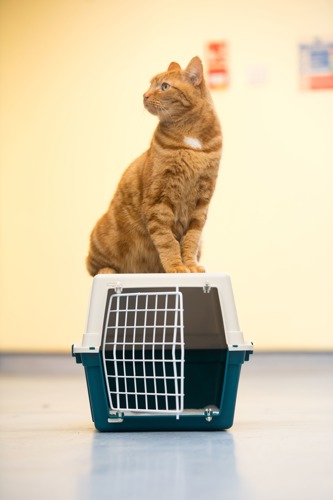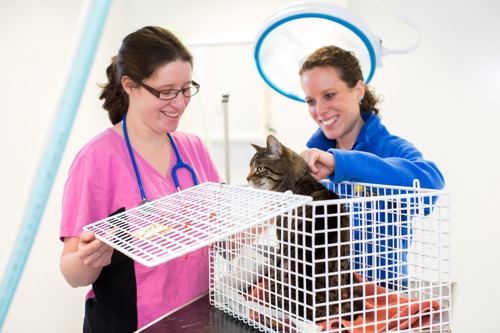12 handy hints and tips from vet experts to make vet appointments with your cat easier
Taking a cat to the vet can be a challenging experience for both pet and owner. From being put into the cat carrier, to being poked and prodded on the examination table, every stage of the process is likely to be stressful for a cat. And as much as we might try to tell them, unfortunately they don’t understand that it’s important for their own health.

Some owners might find vet visits such an ordeal that they put off making appointments, but it’s vital that cats have a check-up with the vet at least once a year so any problems can be identified early. If you notice any changes in your cat’s behaviour or health then it’s important you book them in for a vet visit as soon as possible, as it could be a sign that something is wrong.
To help make trips to the vet a bit easier for everyone involved, try our vet-approved tips for less stressful vet appointments.
1. Book the appointment for a quiet time
This might be difficult to do as vets can be busy at all hours of the day, but if your cat is particularly stressed by vet visits then you could ask the veterinary practice if there are any times that are usually quieter, and therefore less overwhelming for you cat, and book an appointment for then.
2. Find a vet with a cat-only waiting room
When choosing a vet, try to find one close by to limit journey times for your cat. Some vets also offer separate waiting rooms for different animals, so the sights, smells and sounds of other species don’t stress them out. You might be able to find a vet near you that offers a cat-only waiting room for a less stressful experience. Look out for practices that have International Society of Feline Medicine (ISFM) Cat Friendly Clinic accreditation.
3. Get your cat used to the carrier
Make sure you have a suitable cat carrier that’s big enough for your cat to lie down in, well-ventilated and ideally top opening. If your cat is wary of the carrier, try leaving it out at all times, not just before a vet appointment, so they can get used to it and explore it on their own terms. You can also follow our cat carrier training guide to help you entice them inside.

4. Use a pheromone spray
To help your cat feel safer and calmer inside the cat carrier, place their unwashed bedding containing their scent into the carrier so it smells familiar to them. Alternatively, place a blanket or towel inside and spray it with a pheromone spray like Feliway at least 15 minutes before your cat is due to go in it.
5. Don’t feed your cat just before
To avoid your cat vomiting or toileting inside their cat carrier, limit the amount of food they eat for a couple of hours before the journey to the vets, unless you’ve been told otherwise by the vet. If they do have any accidents, placing a blanket or towel inside the carrier will help soak up any mess. Take some spares with you so can swap them over for the journey home.
6. Keep the carrier covered
While your cat is inside, cover the carrier with a large sheet or towel, while making sure there is enough ventilation, to help keep them calm on the journey to and from the vets.
7. Stay calm
Staying calm yourself will help your cat to relax. If you’re driving to the vets, keep any music or talking in the car at a low volume, and drive as smoothly as possible. If you’re walking or getting public transport, move carefully and try to avoid any busy, noisy areas if you can.
8. Keep it cool
Avoid travelling during the hottest part of the day with your cat if you can. If you’re travelling to the vets by car, temperatures inside the vehicle can get dangerously high on hot days. Try to keep the ambient temperature between 5˚C and 30˚C, but keep the windows firmly shut just in case your cat manages to escape from their carrier.
9. Wait outside until the appointment
If you think your cat will find the vet waiting room stressful, you can call reception to let them know you’ll be waiting outside or in the car until the vet is ready to see your cat. Ask them to give you a call or come and get you when it’s time to go in.

10. Leave your cat in the carrier until the vet is ready
When you get inside the examination room, leave your cat inside the carrier until the vet is ready to examine them. You might need to chat to the vet about your concerns for a while first, and so leaving your cat inside the carrier will help keep them calm while you do this. When it’s time for your cat to be examined, allow them to exit the carrier in their own time and don’t attempt to tip them out of the carrier. Top-opening carriers are ideal as you will be able to gently lift your cat out if necessary, or the vet may even be able to examine them while they stay in the bottom of the carrier.
11. Prepare a list of questions in advance
To help keep the amount of time your cat needs to be at the vets to a minimum, prepare a list of your concerns and questions in advance, perhaps writing them down to help you remember. Put the most important points at the top of the list, so that those can be addressed first. If your cat becomes extremely stressed, consider leaving the less urgent points for another appointment or speak to your vet about them over the phone instead.
12. Let your cat relax when they get home
When you get home from the vets, let your cat exit their carrier at their own pace, and leave them alone as much as possible so they can calm down. For the rest of the day try to avoid anything else that might stress them out, such as making lots of noise or having lots of people over, as this will build on the stress they’ve already experienced.
Discover advice for finding a vet and more information about common cat health issues.

